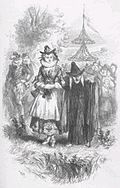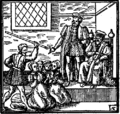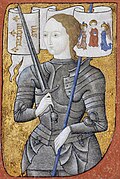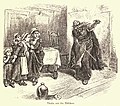List of 999 women of the Heritage Floor / Petronilla de Meath
This list describes the place setting for Petronilla de Meath on the table of Judy Chicago's art installation The Dinner Party . It is part of the list of 999 women on the Heritage Floor who are assigned to the respective place settings on the table. The names of the 999 women are on the tiles of the Heritage Floor, which is arranged below the table and belongs to the art installation.
description
The installation consists of a three-sided table, each with 13 historical or mythological personalities, thus a total of 39 people, from prehistory to the women's rights movement . These people were assigned a place setting at the table, consisting of an individually designed table runner, an individually designed plate, a goblet, knife, fork, spoon and serviette. The first page of the table is devoted to prehistory up to the Roman Empire , the second to Christianization up to the Reformation and the third from the American Revolution to the women's movement. Each place setting on the table is assigned additional personalities who have received an entry on the tiles of the Heritage Floor, which occupies the space under the table and the center of the space between the sides of the table. This list includes the personalities assigned to Petronilla de Meath's place setting. Your seat is on the second side of the table.
Hints
In addition to the names as they are used in German transcription or in scientific usage, the list shows the spelling chosen by Judy Chicago on the tiles.
The information on women who do not yet have an article in the German-language Wikipedia is referenced by the individual references listed under comments . If individual information in the table is not referenced via the main article, additional individual references are given at the relevant point. If there are any discrepancies between the information provided in Wikipedia articles and the descriptions of the work of art on the Brooklyn Museum website , this will also be indicated under Comments.
Place setting for Petronilla de Meath
Petronilla de Meath wasbornin Ireland around 1300. The exact date of birth is not known, nor is a surname recorded. The name de Meath stands for from Meath , which means that it comes from County Meath . She workedas a maidfor Lady Alice Kyteler , who was charged as a witch after the death of her fourth husband. Petronilla was also accused of witchcraft, tortured and forced to proclaim that she and Lady Kyteler were guilty of witchcraft. Along with Kyteler and Petronilla, ten other people were accused of witchcraft, including Petronilla's daughter, Sarah (sometimes called Basilia), and Alice Kyteler's son, William Outlaw. The charges brought against Lady Kyteler by Bishop Richard de Ledrede of Ossory included a wide variety of crimes. These included sorcery and demonism, but also the murder of their husbands. Lady Alice's stepchildren from their marriages to the deceased also joined this accusation. It was believed that Lady Alice magically and diabolically acquired her wealth illegally.
Under the torture, Petronilla stated that she and her lover applied a magical ointment to a wooden beam that allowed both women to fly. Lady Alice was able to flee to England in time, Petronilla's daughter Sarah took her with her. Some of the co-defendants were convicted and flogged, but others, including Petronilla, were burned alive at the stake. Petronilla died after being tortured at the stake on November 3, 1324.
The design of the table setting for Petronilla features many symbols of witchcraft from her time to the present. The initial letter "P" is decorated as a broomstick. Strong colors and shapes on the plate represent the symbol of fire, which, according to Judy Chicago, was abused as a terrible reversal of the sacred fire that once burned in honor of the goddess. There are also other witch symbols on the plate, including a cauldron, a book and a candle. The cauldron commemorates the Great Mother , to whom the witchers pay homage. The table runner is enriched with Celtic motifs, which are based on the Book of Kells . A stylized goat is a horned shape on the back of the runner. The red cords on the black front edge are reminiscent of the red witch's garter, which meant a higher rank in the circle of witches.
| Surname | Spelling on the tile | Date of birth | cultural spatial assignment | Remarks | image |
|---|---|---|---|---|---|
| Agnes Sampson | Agnes Sampson | 16th century | Scotland | Healer who is a key witness in the witch trials in North Berwick was. She was tortured and forced to confess to conspiring with 200 other women to collaborate with the devil in an attempt to defeat King James VI. to kill. She was found guilty and executed in 1591. |

|
| Agnes Waterhouse | Agnes Waterhouse | around 1503 | England | First woman murdered for witchcraft in England. |

|
| Alice Kyteler | Alice Kyteler | 1263 | Ireland | Called the Witch of Kilkenny . She was one of the first women in Ireland to be accused of witchcraft. All of her husbands died, leaving her a fortune. She was charged with murdering her. Because of her aristocratic connections she was able to evade further accusations of witchcraft and escaped to England in 1325. Her servant Petronilla de Meath was executed as a witch after torture. | |
| Alice Samuel | Alice Samuel | 16th century | England | As an older woman, she was accused of being a witch by her employer's children. She was tried in 1593 and hanged along with two relatives as a result of the children's testimony. | |
| Angéle de la Barthe | Angéle de la Barthe | around 1230 | Kingdom of France | Lady, she was accused of witchcraft and confessed under torture. She was convicted and burned alive. The city of Toulouse has no record of its trial and historians have questioned the veracity of the story. | |
| Ann Glover | Goody Glover | 17th century | Massachusetts Bay Colony | The last person to be hanged as a witch in Boston died in 1688, although the Salem Witch Trials in nearby Salem , Massachusetts mostly took place in 1692. |

|
| Anna Maria Schwegelin | Anna Maria Schwagel | 1729 | Prince Abbey of Kempten | Was sentenced to death in 1775 as the last “ witch ” in Germany . In 1998 a historian discovered that the sentence had not been carried out and that the accused died in 1781 in the prison of the prince monastery of Kempten. |

|
| Anne Redfearne | Anne Redfearne | 16th century | England | Hanged in 1612 as one of the eleven Pendle witches in the most famous witchcraft trial in English history. She consistently refused to admit her guilt and gave no evidence against any of the other defendants. |

|
| Catherine Monvoisin | Catherine Deshayes | around 1640 | Kingdom of France , Paris | French fortune teller, poisoner and alleged sorceress, one of the main characters in the affaire des poisons , during the reign of Louis XIV. |

|
| Elizabeth Southern | Elizabeth Southern | 16th century | England | One of the witches charged in the 1612 Pendle Witches trials, which are among the most famous witch trials in English history. She died waiting for the trial. |

|
| Geillis Duncan | Geillis Duncan | 16th century | Scotland | Has been accused of being a witch. |

|
| Gertrud Svensdotter | Gertrude Svensen | 1656 | Sweden | A confessed witch whose confession marked the beginning of the Mora witch trial and eventually the Swedish witch trials. | |
| Guglielma | Guillemine | 12th century | Lombard League , Milan | A woman who preached that she would be resurrected incarnated as the Holy Spirit , and that this would lead to a new church led by women. | |
| Jacqueline Felice de Almania | Jacobe Felicie | 13th century | Kingdom of France , Paris | Doctor who practiced in Paris. In 1322 she was forbidden to continue practicing under threat of excommunication and as a result there were no women doctors in France until the 19th century. | |
| Jane Weir | Jane Weir | 17th century | England | Accused of incest and witchcraft in 1670 and executed. | |
| Joan of Arc | Joan of Arc | 1412 | Kingdom of France | French national heroine . She is venerated as a virgin and saint in the Roman Catholic Church . They are also remembered in the Church of England . |

|
| Madeleine de Demandolx de la Palud | Madeleine de Demandolx | around 1592 | Kingdom of France | Nun, one of the alleged cases of demonic possession that occurred among the Ursulines of Aix-en-Provence in 1611 . | |
| Margaret Jones | Margaret Jones | 1648 | Massachusetts Bay Colony | Midwife, executed for witchcraft in Massachusetts Bay Colony from 1648 to 1663 as the first victim of the witch hunt. | |
| Margareta Porete | Margaret of Porète | around 1250/1260 | Kingdom of France | Theological writer belonging to the Beguines religious movement . As the author of Le mi rouer des simples ames , she was publicly executed at the stake . | |
| Margery Jourdemain | Margery Jourdemain | around 1400 | England | Witch of Eye , victim of a political conspiracy , was found guilty of sorcery and treason against the king and was publicly burned as a witch on October 27, 1441. | |
| Maria de Zozaya | Maria de Zozoya | around 1539 | Basque Country | Persecuted as a witch in 1609 during the Basque witch trials that were part of the Spanish Inquisition . | |
| Maria Salvatori | Maria Salvatori | 17th century | Holy Roman Empire , Nogaredo | When Hexenprozess Nogaredo accused of being a witch. | |
| Pierrone | Pierrone | 15th century | Kingdom of France | 15th century Breton woman who had a vision of "God dressed in a long white robe with a red tunic underneath". Pierronne tried to defend her reputation in Corbeil. She was arrested in March 1430 and burned at the stake on September 3, 1430. | |
| Tituba | Tituba | around 1650 | Massachusetts Bay Colony | Barbados or Guiana slave owned by Samuel Parris of Salem. Tituba was one of the first three people to be accused of practicing witchcraft during the Salem Witch Trials in 1692. Tituba confessed and charged other women in the colony in order to save herself from execution. It was later sold by Parris and taken outside of Salem. |

|
| Ursula Kemp | Ursley Kempe | around 1525 | England | English woman accused of causing three deaths and hanged for witchcraft. |
- Individual evidence
- ↑ Brooklyn Museum: Petronilla de Meath. In: brooklynmuseum.org. Retrieved October 23, 2019 .
- ^ Brooklyn Museum: Agnes Waterhouse. In: brooklynmuseum.org. Retrieved October 23, 2019 .
- ↑ Brooklyn Museum: Alice Samuel. In: brooklynmuseum.org. Retrieved September 22, 2019 .
- ↑ Brooklyn Museum: Angéle de la Barthe. In: brooklynmuseum.org. Retrieved October 23, 2019 .
- ↑ Brooklyn Museum: Goody Glover. In: brooklynmuseum.org. Retrieved October 23, 2019 .
- ↑ Brooklyn Museum: Geillis Duncan. In: brooklynmuseum.org. Retrieved October 23, 2019 .
- ↑ Brooklyn Museum: Gertrude Svensen. In: brooklynmuseum.org. Retrieved October 23, 2019 .
- ↑ Brooklyn Museum: Guillemine. In: brooklynmuseum.org. Retrieved October 23, 2019 .
- ↑ Brooklyn Museum: Jacobe Felicie. In: brooklynmuseum.org. Retrieved October 23, 2019 .
- ↑ Brooklyn Museum: Jane Weir. In: brooklynmuseum.org. Retrieved October 23, 2019 .
- ↑ Brooklyn Museum: Maria de Zozoya. In: brooklynmuseum.org. Retrieved October 23, 2019 .
- ^ Brooklyn Museum: Maria Salvatori. In: brooklynmuseum.org. Retrieved October 23, 2019 .
- ↑ Brooklyn Museum: Pierrone. In: brooklynmuseum.org. Retrieved October 23, 2019 .
- ^ Brooklyn Museum: Ursley Kempe. In: brooklynmuseum.org. Retrieved October 23, 2019 .
Web links
- Brooklyn Museum, Petronilla de Meath
- The Dinner Party on the website of Through the Flower , Judy Chicago's non-profit organization
